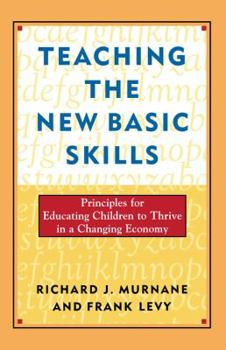Teaching the New Basic Skills: Principles for Educating Children to Thrive in a Changing Economy
Select Format
Select Condition 
Book Overview
Fifteen years ago, a U.S. high school diploma was a ticket to the middle class. No longer. The skills required to earn a decent income have changed radically. The skills taught in most U.S. schools have not. Today the average 30-year-old person with a high school diploma earns $20,200, and the nation faces a future of growing inequality and division. Teaching the New Basic Skills shows how to avoid such a future. By telling stories of real people in real businesses and real schools, the book shows the skills students need to get decent jobs and how schools can change to teach those skills.
Richard Murnane and Frank Levy begin by describing the hiring processes of best practice firms like Northwestern Mutual Life and Honda of America. In today's competitive economy, these firms search for applicants with the New Basic Skills -- the mix of hard and soft skills that all high-wage employers now require. Murnane and Levy then shift their analysis to schools, asking how they can more effectively teach these New Basic Skills. By using case studies the authors show that popular school reform proposals -- higher standards, school choice, national standards, charter schools, more money -- can only be the first half of a solution to the nation's school problem. When they work as advertised, they force a school to change the way it does business. But each of these reforms needs a second half, a strategy for guiding schools toward the changes that raise student skills.
The authors show how that strategy rests on five management principles that focus a school on student achievement. These principles grow out of the experiences of real schools doing the dirty work of educational reform: an elementary school in East Austin, Texas organizing low-income Hispanic parents around higher educational performance, an affluent New England community retraining its teachers, the state of Vermont devising new ways to measure the math skills employers require, a Boston high school creating incentives for low-income minority students to devote more time and attention to schoolwork.
Superintendents, governors and business leaders agree on the importance of this book as evidenced in the forewords by Robert Galvin, Chairman of Motorola, and Thomas Payzant, school superintendent of Boston. For those who care about the success of U.S. schools, Teaching the New Basic Skills is an optimistic guide to the future and a must read.
Richard Murnane and Frank Levy begin by describing the hiring processes of best practice firms like Northwestern Mutual Life and Honda of America. In today's competitive economy, these firms search for applicants with the New Basic Skills -- the mix of hard and soft skills that all high-wage employers now require. Murnane and Levy then shift their analysis to schools, asking how they can more effectively teach these New Basic Skills. By using case studies the authors show that popular school reform proposals -- higher standards, school choice, national standards, charter schools, more money -- can only be the first half of a solution to the nation's school problem. When they work as advertised, they force a school to change the way it does business. But each of these reforms needs a second half, a strategy for guiding schools toward the changes that raise student skills.
The authors show how that strategy rests on five management principles that focus a school on student achievement. These principles grow out of the experiences of real schools doing the dirty work of educational reform: an elementary school in East Austin, Texas organizing low-income Hispanic parents around higher educational performance, an affluent New England community retraining its teachers, the state of Vermont devising new ways to measure the math skills employers require, a Boston high school creating incentives for low-income minority students to devote more time and attention to schoolwork.
Superintendents, governors and business leaders agree on the importance of this book as evidenced in the forewords by Robert Galvin, Chairman of Motorola, and Thomas Payzant, school superintendent of Boston. For those who care about the success of U.S. schools, Teaching the New Basic Skills is an optimistic guide to the future and a must read.
Format:Hardcover
Language:English
ISBN:0684827395
ISBN13:9780684827391
Release Date:September 1996
Publisher:Free Press
Length:272 Pages
Weight:1.05 lbs.
Dimensions:1.0" x 6.0" x 8.6"
Customer Reviews
2 ratings
One of the best books on education reform
Published by Thriftbooks.com User , 27 years ago
This is an excellent and realistic book, with no quick fix solutions. It shows that schools need to teach not only basic math and reading, but also the ability to work in groups and to communicate effectively, as well as to solve problems. High school graduates need these skills to get good jobs. Simple solutions such as charter schools, choice, and more tests will not suffice. Hard work and perseverence at the local school level is needed.
Good book, but like many others on education, unrealistic.
Published by Thriftbooks.com User , 27 years ago
This book is about what it takes to get a good job in manufacturing (Honda, for example) or services (insurance) and how the schools are failing to provide students with the "new basic skills" which will enable them to get these jobs. The analysis of what's wrong is similar to other analyses, and it is accurate: the average high school graduate doesn't know very much and doesn't really care that he doesn't know much. My quarrel with this book is that the authors underestimate the difficulty of changing the situation. Improving operations at Honda in Marysville, Ohio, is NOT the same thing as trying to produce high quality students. Schools have become social service agencies, and learning enough to get a good job at Honda is only one of many purposes the schools serve, and on any given day it may not be the most important






